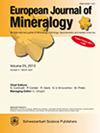Structural and compositional data for childrenite from the Homolka granite, Czech Republic
IF 1.7
3区 地球科学
Q2 MINERALOGY
引用次数: 0
Abstract
Abstract. Members of the childrenite–eosphorite series, ideally (Fe1−xMnx)AlPO4(OH)2⋅H2O, from the highly evolved Homolka granite, in the southern Czech Republic, were characterized using a multi-analytical approach. They occur as anhedral grains, up to ∼0.2 mm in size, associated with quartz, muscovite, albite, and K-feldspar. Tiny inclusions of probable uraninite have been observed. Backscattered electron images reveal a patchy zoning of these members of the childrenite–eosphorite series, related to an uneven distribution of Fe and Mn. On the basis of electron microprobe analysis, the average composition of the studied material is (Fe0.68Mn0.28Ca0.03)Σ0.99Al0.96(P1.04Si0.01)Σ1.05O4.00(OH)2.09⋅0.91H2O, thus corresponding to childrenite. Unit-cell parameters of this species are a=6.9226(9), b=10.4081(13), c=13.3957(17) Å. Its crystal structure was refined in the space group Cmca down to R1=0.0295 on the basis of 602 unique reflections with Fo>4σ(Fo) and 66 refined parameters. The crystal structure analysis agrees with the results of electron microprobe analysis and suggests that, in the studied material, Fe occurs in the divalent oxidation state only. Crystal structure data are also consistent with the Raman spectrum collected on the same grain that was structurally characterized, confirming the occurrence of PO4 groups only in childrenite.捷克共和国霍莫尔卡花岗岩童子石的结构和成分数据
摘要。采用多重分析方法对捷克共和国南部高度演化的霍莫尔卡花岗岩中的童子石-萤石系列(理想状态下为 (Fe1-xMnx)AlPO4(OH)2⋅H2O) 成员进行了表征。它们呈正方体颗粒,大小可达 0.2 毫米,与石英、黝帘石、白云石和 K 长石伴生。还观察到可能含有铀矿石的微小包裹体。背散射电子图像显示,这些童子岩-磷帘石系列成员呈斑块状分带,这与铁和锰的不均匀分布有关。根据电子微探针分析,所研究材料的平均成分为(Fe0.68Mn0.28Ca0.03)Σ0.99Al0.96(P1.04Si0.01)Σ1.05O4.00(OH)2.09⋅0.91H2O,因此与童子石相对应。其单位晶胞参数为 a=6.9226(9)、b=10.4081(13)、c=13.3957(17) Å。根据 Fo>4σ(Fo)的 602 个独特反射和 66 个精制参数,在空间群 Cmca 中对其晶体结构进行了精制,精制参数为 R1=0.0295。晶体结构分析与电子微探针分析结果一致,表明在所研究的材料中,铁仅处于二价氧化态。晶体结构数据还与在同一晶粒上采集到的拉曼光谱相一致,证实了童子石中只存在 PO4 基团。
本文章由计算机程序翻译,如有差异,请以英文原文为准。
求助全文
约1分钟内获得全文
求助全文
来源期刊
CiteScore
2.80
自引率
9.50%
发文量
40
审稿时长
6-12 weeks
期刊介绍:
EJM was founded to reach a large audience on an international scale and also for achieving closer cooperation of European countries in the publication of scientific results. The founding societies have set themselves the task of publishing a journal of the highest standard open to all scientists performing mineralogical research in the widest sense of the term, all over the world. Contributions will therefore be published primarily in English.
EJM publishes original papers, review articles and letters dealing with the mineralogical sciences s.l., primarily mineralogy, petrology, geochemistry, crystallography and ore deposits, but also biomineralogy, environmental, applied and technical mineralogy. Nevertheless, papers in any related field, including cultural heritage, will be considered.

 求助内容:
求助内容: 应助结果提醒方式:
应助结果提醒方式:


